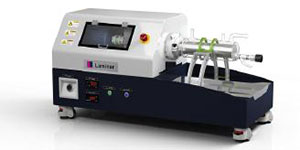What is a Taylor-Couette Fluid Flow Reactor?
What is Taylor-Couette Flow?
Taylor-Couette Flow is the flow of a viscous fluid when confined in the gap between two rotating cylinders; a round bar-type cylinder is inserted into a pipe-type cylinder. The resulting fluid flow is called Taylor-Couette flow.
The fluid flows in the rotating direction as the inner cylinder rotates, but there occurs a force for the fluids on the inner cylinder to go to the outer cylinder direction via a centrifugal force and a Coriolis force, so the fluid flow becomes gradually unstable as the rotation speed increases to create vortexes of ring pair array rotating regularly and in the counter directions along the axial direction.
A Taylor-Couette fluid flow can generate a turbulent flow by changing the rotational speed of the inner cylinder and is widely used to study the stability of a fluid.
For a viscous fluid, it was reported that a Taylor Vortex occurs in a domain larger than the critical Taylor number based on linear theory. The instability condition of a flow can be represented as a Taylor number (Ta), which is defined by a rotational direction Reynolds number and a reactor shape factor(d/R1) as follows:
Where d is the distance between two cylinders, R1 is the radius of the inner cylinder, ω1 is the rotational angular speed of the inner cylinder, and ν is the dynamic viscosity of the fluid.

A diagram illustrating Taylor-Couette Flow.
Laminar Continuous Taylor Reactors
Analytik provides Taylor-Couette Fluid Flow Reactors developed by South Korean manufacturer Laminar. Laminar’s patented chemical production technology commercialised Taylor Fluid Flow, developed by Couette in the early 1900s and analysed by Taylor in the mid-1900s, to develop the first Continuous Taylor Flow Reactor in 2010.
Laminar Continuous Taylor Reactors (LCTRs) have since been optimised for the manufacture of Li-ION batteries, development of nano materials and production of Graphene Oxide, and adopted by leading organisations across the globe.

Further reading: How does a Taylor-Couetter Reactor work?


